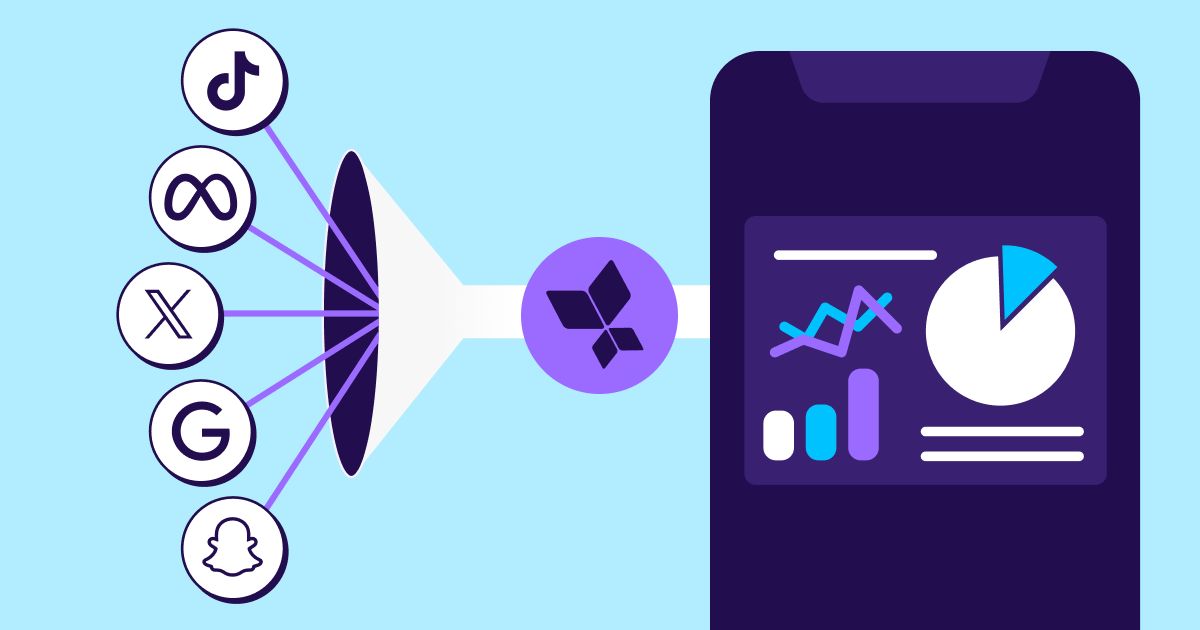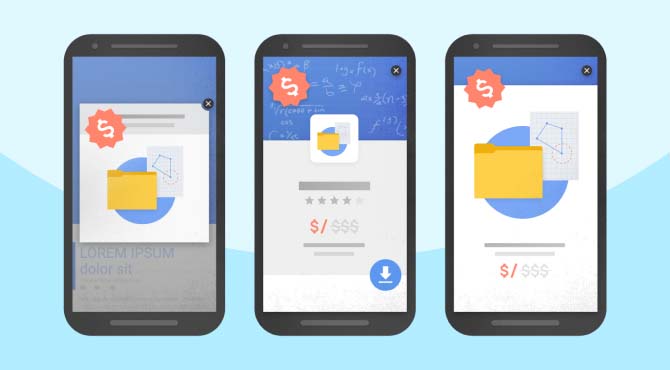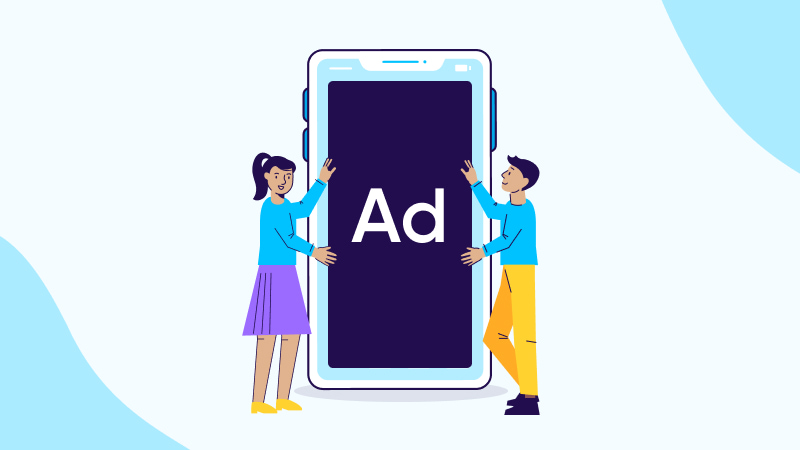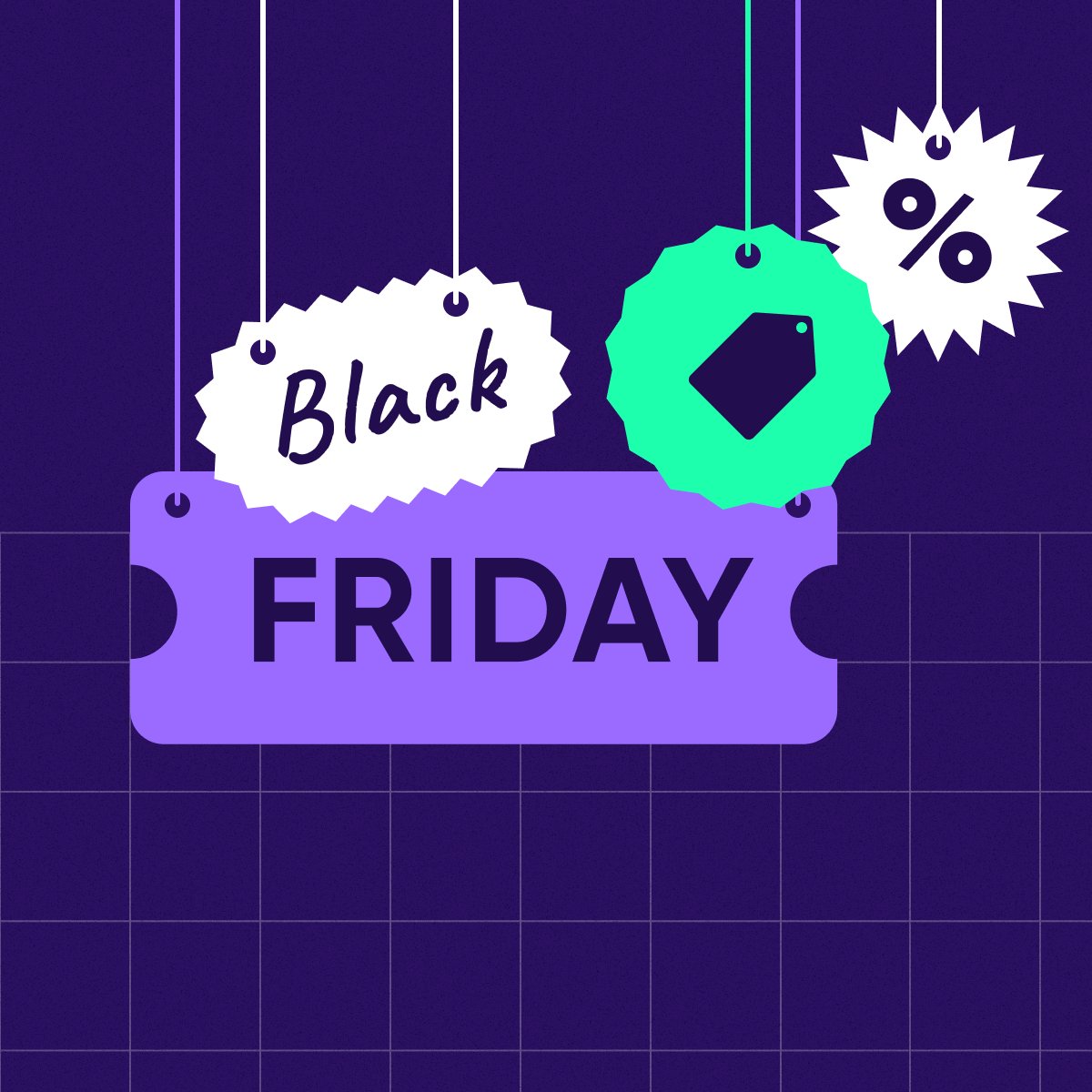
Interstitials
Los interstitial ads son ad placements a pantalla completa que aparecen en pausas naturales o puntos de transición en la aplicación o la experiencia web de un usuario.
¿Qué son los interstitial ads?

Estos anuncios interactivos captan la atención al llenar toda la pantalla en puntos establecidos en la experiencia en línea de un usuario. El usuario puede optar por cerrar el anuncio o hacer clic en su destino.
Aunque se asocian más con aplicaciones móviles, los interstitials también se pueden usar en sitios web móviles o de ordenador. Vienen en varios formatos, incluidos estáticos (para imágenes o texto) y medios enriquecidos (para video).
Los interstitials no deben confundirse con los anuncios pop-up: si bien puede parecer que ambos interrumpen tu experiencia, los pop-ups solo cubren un área pequeña, mientras que los interstitials llenan toda la pantalla. Como resultado, solo deben usarse en interrupciones naturales en la actividad del usuario. Los anuncios publicitarios, por su parte, se fijan en la parte superior o inferior de la pantalla, lo que los hace vulnerables a la “ceguera de los banners”.
¿Cómo funcionan los interstitials?
Como se mencionó, aparecen en puntos de transición naturales en una experiencia de aplicación o sitio web, como entre niveles de juego. Debido a que llenan la pantalla y generalmente son inmunes a los bloqueadores de anuncios, pueden verse como intrusivos. Es por eso que Google impone sanciones por el uso indebido de ellos (más sobre esto a continuación).
Son interactivos porque el usuario puede elegir si desea participar o no. Si hacen clic en el anuncio, se les sacará de su aplicación o sitio y se dirigirá al destino del anunciante. Alternativamente, pueden tocar la cruz para cerrar el anuncio y continuar con su actividad. Por lo general, los anuncios estáticos se pueden cerrar de inmediato, mientras que los videos pueden requerir que el usuario los vea durante un tiempo determinado (generalmente cinco segundos).
¿Dónde puedo encontrarlos?
Se pueden usar en diferentes dispositivos, echemos un vistazo más de cerca.
Interstitials de aplicaciones móviles
Estos tipos de interstitials son anuncios de página completa que se publican durante la navegación de la aplicación móvil. Se muestran en los puntos de transición naturales de la aplicación, como el inicio, la carga del nivel del juego o el pre-roll de vídeo.
Estos anuncios son excelentes para los anunciantes de marcas: son muy atractivos e imposibles de ignorar. Y, como sabemos, aumentar el engagement de los usuarios es una forma a prueba de balas para garantizar más clics y conversiones.
Interstitials de sitios web móviles
Al igual que los de aplicaciones, se trata de anuncios de página completa. La diferencia es que se muestran entre las páginas vistas en un sitio web móvil, lo que ayuda a los publishers a monetizar sus páginas web.
No se pueden mostrar apenas llega un usuario a tu sitio web. Se activan cuando el usuario navega entre determinadas páginas y tienen un límite de frecuencia para proteger la experiencia del usuario. Esto significa que algunos tipos de sitios móviles, como los de una sola página o los de desplazamiento infinito, no serán adecuados para los interstitials.
Interstitials de ordenador
Funcionan de manera similar a los móviles, aparecen entre las vistas de página en un sitio web de ordenador y están sujetos a restricciones similares. Estos interstitials son menos populares que sus contrapartes móviles: si bien son lucrativos para los editores, son más intrusivos para los usuarios y es posible que no obtengan suficientes vistas para ser rentables para los anunciantes.
¿Cuáles son los beneficios de usar este tipo de anuncios?
Son populares tanto entre los anunciantes como entre los publishers, así que te explicamos por qué.
Beneficios para los anunciantes
- Buena visibilidad: No hay riesgo de ceguera de banner con un interstitial, simplemente no puedes perdértelo. Y el enfoque de pantalla completa significa que los anunciantes tienen mucho espacio para transmitir su mensaje, incluso en una pantalla pequeña de un móvil.
- Alto engagement: En el momento adecuado y dirigidos cuidadosamente, los interstitials ads son una oportunidad de oro para atraer a tu audiencia. Es por eso que estos anuncios obtienen una puntuación alta en impresiones e interacciones.
- Alta tasa de click-through (CTR): Es más probable que las audiencias comprometidas hagan clic, lo que te acerca un paso más a una conversión.
- Amplio alcance: Debido a que los interstitials no se limitan solo a las aplicaciones, puedes conectarte con audiencias a través de diferentes dispositivos.
- Flexibilidad creativa: La variedad de formatos te permite contar tu historia de la manera más atractiva y efectiva, ya sea a través de palabras, imágenes, videos o incluso un juego interactivo.
Beneficios para los editores
Los beneficios anteriores también son relevantes para los editores (propietarios de aplicaciones o sitios web). Esto se debe a que todos contribuyen a aumentar los ingresos.
Los anunciantes están dispuestos a pagar por este nivel de alcance y engagement, mientras que la limitación de frecuencia brinda a los publishers un alto nivel de control sobre quién ve qué anuncios y cuándo. Esto significa que los editores pueden cobrar un premium por su inventario y lograr un eCPM saludable.
Penalización interstitial de Google

Si bien los interstitial ads pueden parecer el boleto soñado para los anunciantes y publishers que buscan aumentar los ingresos, la experiencia no siempre es tan positiva para los usuarios. No hay duda de que estos anuncios pueden ser intrusivos, y es por eso que Google introdujo reglas para minimizar la frustración del usuario.
Las marcas y los publishers deben cumplir con las políticas de Google destinadas a proteger a los usuarios de la publicidad intrusiva en línea. Aquellos que no lo hagan se enfrentarán a sanciones financieras y correrán el riesgo de que su sitio web baje la clasificación.
Las reglas de Google no permiten lo siguiente:
- Interstitials servidos en la página de carga o salida de tu sitio
- Interstitials servidos en cada pausa del usuario
- Interstitials que cubren la intención de búsqueda de una página mientras un usuario está navegando
- Interstitials que interrumpen inesperadamente al usuario en medio de una tarea, lo que puede provocar clics accidentales
- Interstitials independientes que requieren que el usuario lo descarte antes de acceder al contenido principal
Hay algunas excepciones: los interstitials están permitidos por obligaciones legales, como el uso de cookies o la verificación de edad, y cuando se pasa a otra página que no se puede encontrar a través de la búsqueda de Google (cruzando un paywall, por ejemplo).
Prácticas recomendadas para interstitials
Antes de implementar anuncios interstitials en tu aplicación o sitio web, ten en cuenta las siguientes prácticas recomendadas para aprovechar al máximo tu campaña:
Conoce tu lugar – Colocación de anuncios

El cuándo y el dónde de la colocación de tu anuncio es crucial. Utiliza las pruebas A/B para asegurarte de que tus anuncios se coloquen en las pausas naturales de los usuarios en tu aplicación o en tu sitio web.
Por ejemplo, en una aplicación de juegos, los anuncios deben colocarse al final de un nivel completado. En el caso de un sitio móvil de noticias, puedes colocar interstitials entre los artículos.
Siempre es una buena práctica colocar anuncios después de que un usuario haya interactuado con tu sitio, en lugar de interrumpir su flujo en un punto crucial (un no-no de Google).
No seas molesto – Frecuencia de los anuncios
No se trata solo de dónde los publicas, sino de la frecuencia. No coloques anuncios en cada descanso, ya que no solo es molesto para los usuarios, sino que infringiría la política de Google descrita anteriormente. Las pruebas A/B pueden ayudarte a encontrar la frecuencia con la que seguirás atrayendo y encantando a los usuarios, impulsando el engagement y la retención.

No retengas a los usuarios a la fuerza – Diseño de anuncios
Si bien es tentador mantener todos los ojos fijos en tu anuncio, recuerda que los usuarios no han elegido verlo, y es importante ofrecerles una salida si la desean. Para devolver a los usuarios algo de control, no los obligues a ver videos largos o buscar una X oculta para salir.
Hallazgos clave
- Los interstitials son ubicaciones de anuncios interactivos a pantalla completa que se publican en puntos naturales a lo largo del viaje del usuario en una aplicación, un sitio web móvil o un sitio de escritorio.
- Los interstitials ads pueden ser estáticos o de texto enriquecido, lo que ofrece margen para la creatividad. Su tamaño y ubicación en pantalla completa generan altas tasas de engagement y clics para los anunciantes, lo que se traduce en mayores ingresos para los publisher.
- Es crucial seguir la política de Google sobre interstitials ads para evitar frustrar a los usuarios e incurrir en sanciones. Esto incluye asegurarse de que los anuncios no sean demasiado frecuentes o intrusivos.
- La ubicación y la frecuencia son fundamentales, y las pruebas A/B son la mejor manera de garantizar que se publiquen en el lugar correcto y en los momentos adecuados. Asegúrate de no interrumpir el flujo de usuarios y facilitar que los usuarios salgan del anuncio cuando lo deseen.


